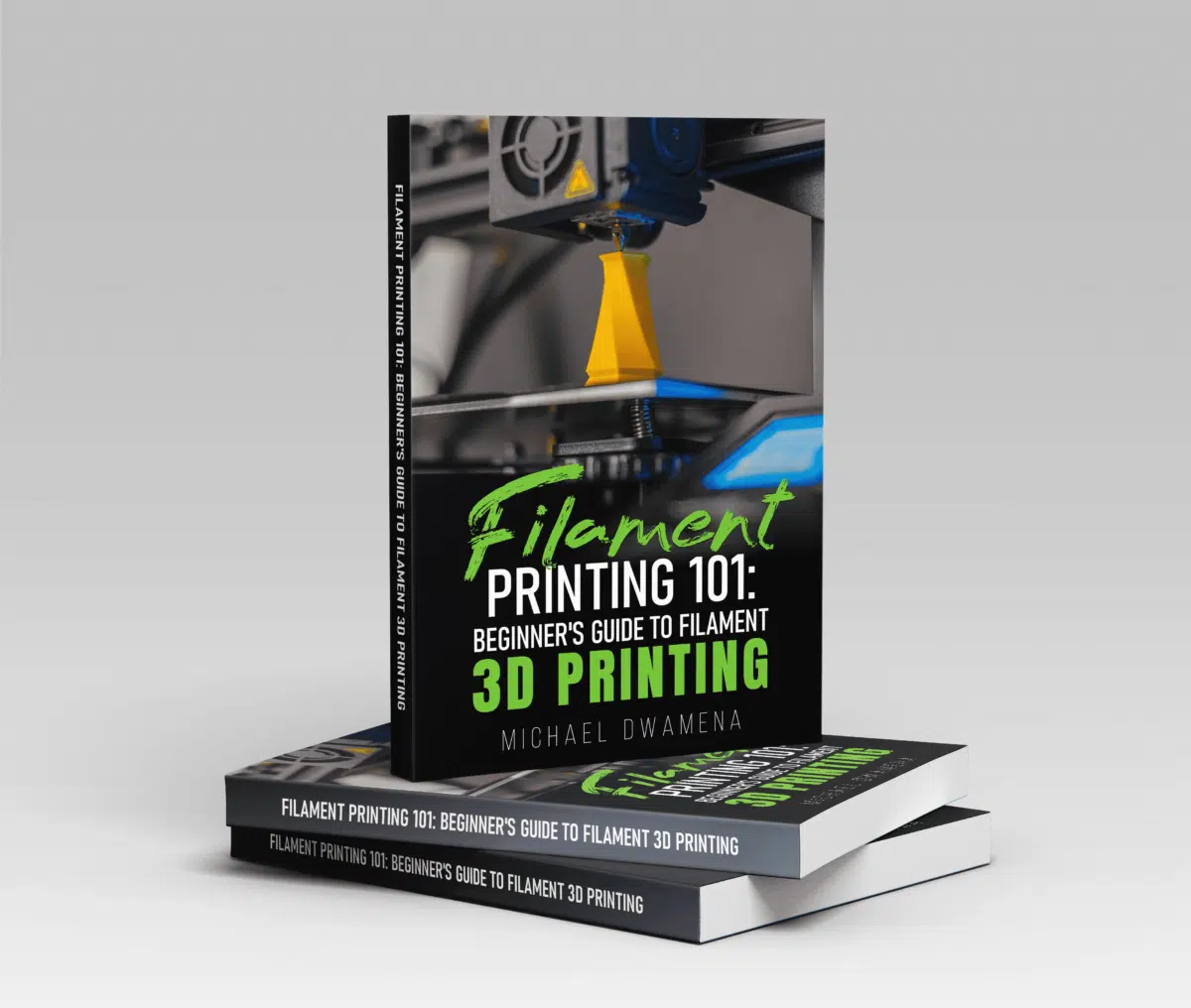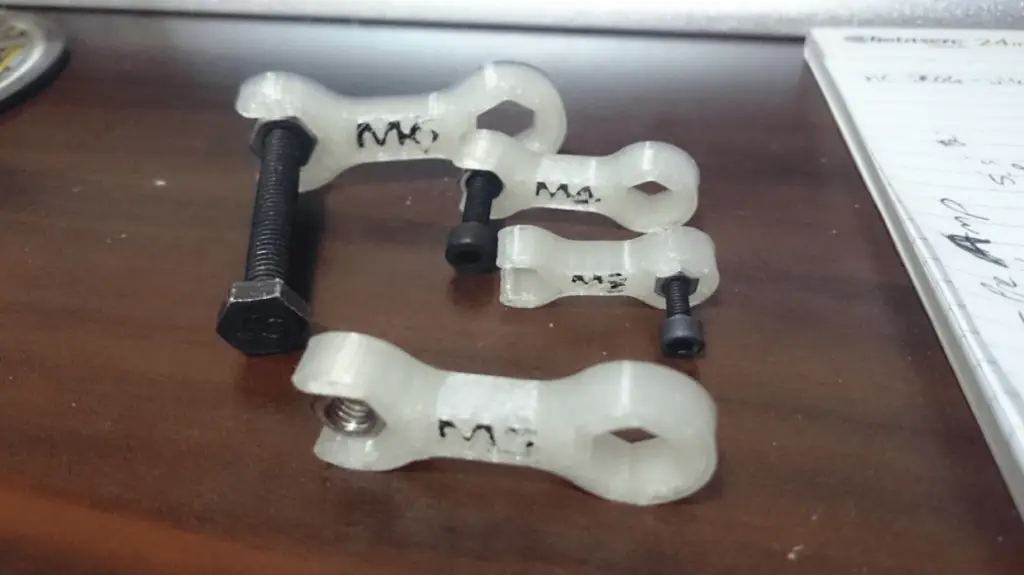If your 3D printer is creating models with a ripple or wave effect on the outside, you have an issue known as ringing or ghosting. When that happens, it’s always caused by one thing: vibrations.
However, figuring out what’s causing vibration can be a significantly more difficult problem than actually fixing the issue.
In most cases, you can fix 3D printer ringing or ghosting by adjusting print speeds and acceleration and jerk settings. If that doesn’t work, you may be able to reduce ringing by adjusting mechanical parts, like belt tension, tightening screws, or stabilizing the printer.
What Is Ringing In 3D Printing?
Ringing, ghosting, rippling, and echoing all refer to the same problem. Here, your 3D prints show waves or ripples in the print. This may include simple layer ripples.
However, it might also include features reappearing but more faintly across the surface of a model.
In addition, while complaints of rippling are common with printers like the Ender 3, ghosting can occur on nearly any printer. You simply see more complaints of issues on very common models, especially those designed to be accessible to beginners.
5 Common Culprits Of 3D Print Ghosting & Ringing
Ghosting and ringing are always caused by vibration. Therefore, if you’re looking for the reason your printer is ghosting, you can check for why it’s vibrating.
Mechanical knowledge can make it significantly easier to troubleshoot. However, the following includes the 5 most common reasons for printer vibration.
1. Printing Too Fast
Most filament types have a print speed recommendation. In addition, most 3D printers have recommended top speeds.
For example, the two most common printing filaments, ABS and PLA, have recommended top speeds of 50-60mm/s.
- Our new Filament Printing 101 Course is just for you! Lean how to create perfect professional prints without all the hassle.
- Don't let common mistakes hold you back, click the link to learn more and get ahead now!
Why does it matter? If you’re printing too fast, the printer arm may vibrate too much. In addition, it may jerk or de-accelerate too fast, even if you have good settings there.
If you’re experiencing ghosting, always check print speed settings first.
2. Acceleration and Jerk Settings
https://www.youtube.com/watch?v=c5MSns79z58
Most slicers include acceleration and jerk settings. These adjust how quickly the print head moves and how the printer attempts to accelerate from 0 to any speed.
If you’re using Cura, it has built-in settings to reduce “jerk”, which you can simply turn on to smooth out prints.
Even the Ender 3 has a built-in control under the “Motion” section on Marlin, although you’ll have to manually adjust the acceleration values, which can require quite a bit of guesswork and troubleshooting.
Acceleration and jerk settings have to be lower for direct drive extruders. That happens because the direct drive extruder is heavier which means that it’s more likely to vibrate when coming to a stop.
For this reason, people with printers frequently experiencing ghosting also like to swap the extruder out for a Bowden model – which is significantly lighter.
3. Belt Tension
If the belt is too loose, it could cause the printer arm to vibrate. This happens as the belt wobbles too much when it rotates, creating mechanical vibration up the arm of the printer.
Here, a too-tight belt can also cause ghosting. However, extra play is the most common cause of belt-caused ghosting.
Most 3D printers have their own recommendations for how tight to make the belt. Unfortunately, this means there’s no one specific setting.
In addition, your printer likely has more than one belt and all of them must be checked.
4. Loose Screws
Loose screws can cause wobble, vibration, and extra play in beds and the printer arm. For example, the Ender 3 build plate attaches to the printer using screws.
If one is loose, it can cause a significant amount of wobble in the build plate. This can result in ghosting or ringing if the print succeeds at all.
Loose screws can impact any part of the printer, but the print head, the arm, and the build plate are most likely to be the issues.
5. Unstable Build Surface
It’s highly possible that your print surface is unstable because of where you’ve placed the printer.
For example, if you’ve placed it on a flimsy table or something like a cardboard box, it could be vibrating too much which will cause ghosting. It’s always important to put your 3D printer on a stable surface, preferably with vibration-dampening feet.
If you can vibrate or rock the printer or the surface it’s on with ease, that’s likely the cause of the ghosting issue.
How To Prevent 3D Printer From Ringing
Preventing 3D printing ghosting normally depends on what’s causing the issue. However, troubleshooting and starting from the most likely causes first is a good way to start.
For example, checking the table and ensuring it’s not vibrating is a good first step. From there, you can also:
1. Reduce Print Speed
Print speed is determined by the printer, the nozzle, and the filament you use. Often, the idea is that you balance between speed and quality. In addition,
In addition, some types of filament require different speeds. For example:
- ABS – 45-60mm/s
- PLA – 40-150mm/s
- TPU – 15-20mm/s
- Nylon – 30-50mm/s
- PETG – 40-60mm/s
The Ender 3 has a range of up to 150 mm/s. This high travel speed allows you to print large and low-detail prints more quickly.
However, for most prints, you probably want something closer to 30-55 mm/s for most high detail prints.
For example, for ABS:
- Initial Layers – Go slow and steady – 20-30mm/s
- Outer Layers (Outer/Inner Wall, Perimeter, Outline) – Go slow – 30-60mm/s
- Infill – As fast as possible – provided this doesn’t cause peeling
- Support Structure – Go slow – 30-60mm/s
- Skirt/Brim – Go slow
- Top Surface – Go slow
- Travel Speed/Retraction Settings – balanced between fast and slow. If it’s too fast, you’ll get ringing; if too slow, you’ll get oozing and stringing. Check your printer’s specific recommendations.
Most 3D printer manufacturers will offer recommended settings per filament they sell. In addition, using a larger nozzle and a larger layer height may allow you to reduce the visibility of slight vibrations – although it may increase layer visibility.
If your print speed is very high, this is likely an easy solution. If you’re within the recommended ranges, you can still try reducing speed by 10mm/s just to see if it helps.
2. Check Acceleration Settings
If your printer has acceleration and jerk settings, you should look at them. For example, Marlin often uses 4,800 mm/s maximum acceleration. Some people prefer to halve that.
In addition, if you use Cura, you’ll want to ensure you’ve enabled jerk reduction.
3. Check Printer and Bed Stability
Check the table your printer is on. Does it wobble or move with slight pressure? Check the bed stability.
Does it manually move or wobble? What if you put a finger on one corner, does it vibrate when pushed? If so, there are likely issues with the bed stability or the table stability, and you can take steps to fix these.
However, instability might not be as simple as a table or a screw. Instead, your machine may contain leveling springs under the bed.
If these lose their stiffness, they can cause a significant amount of wobble. Therefore, if you’ve tried everything else with no results, it may be a good idea to replace the springs – or to remove the bed and check the springs.
4. Check the Belts
Check your 3D printer’s manual to see where the belts are and how you tighten them. Most also offer tension recommendations, such as how to test if the belt is tight enough on your specific model.
In most cases, you can adjust the belt tension by adjusting a screw on the belt.
Here, you normally want the belt to be tensioned to the point where it makes a thrumming sound when you pluck it. However, different printers do offer different recommendations, and it’s always a good idea to check.
In addition, after tightening all of the belts on your printer, you’ll want to double-check to ensure that doing so does not change the tension on another belt.
5. Look for Loose Screws and Parts
Loose screws, bolts, or clamps can all result in ghosting. This normally happens immediately after you put the machine together.
In addition, it might happen after you clean or replace part of the machine.
However, in some cases, vibration can simply cause screws and other parts to come loose over the item, which might mean you have screws or nuts on the floor or on the counter. These can be more difficult to replace – especially if you don’t know they are missing.
Inspect the full printer and double-check with your manual to see if you’re missing anything.
Related Questions
If you still have questions about your 3D printer ringing or ghosting, these answers should help.
How tight should 3D printer belt be?
3D printer belts should be tensioned to the recommendations in the printer’s manual.
If you don’t have a copy, you can normally find it online. However, in most cases, appropriate tightness is about enough for the belt to thrum when plucked.
If it doesn’t make noise at all or if it wobbles, it’s definitely too loose.
In addition, if your belt makes a thudding noise while turning, it is too loose. On the other hand, if it makes a high-pitched whine, it may be too tight.
Can vibration cause damage to 3D printers?
Vibration can cause the mechanical parts of your 3D printer to come loose. This may mean you’ll have to tighten bolts and clamps more often.
However, the larger issue with a vibrating printer is that it causes ghosting and ringing. It is unlikely you’ll be able to create high-quality detailed parts if your 3D printer is vibrating.
Therefore, you’ll likely want to figure out the cause of the issue and fix it as quickly as possible.
Next Steps
If your 3D printer is ringing or ghosting, the issue is caused by vibration. Troubleshooting and isolating the cause of vibration can be tricky. However, ringing is a much more straightforward issue than many other problems with 3D prints.
In most cases, the issue is either settings (speed and acceleration) or mechanical (belt, screw, or tensioner being tight). This means you can go through a fairly short list of potential causes to resolve the issue.
In addition, if you’re still having issues, it’s likely that you can always change the springs under the bed.



